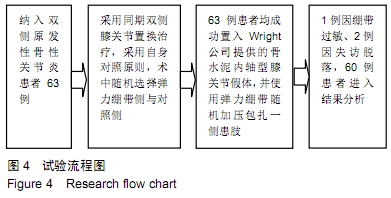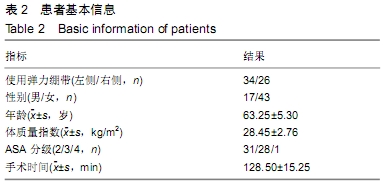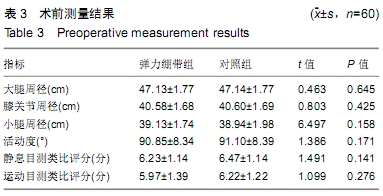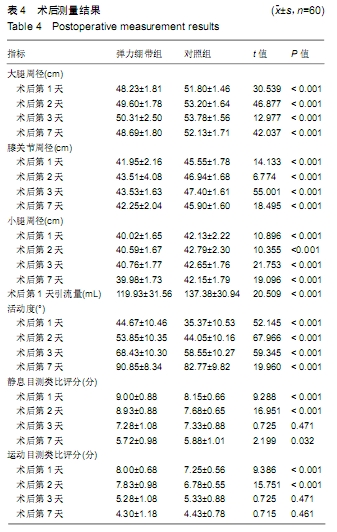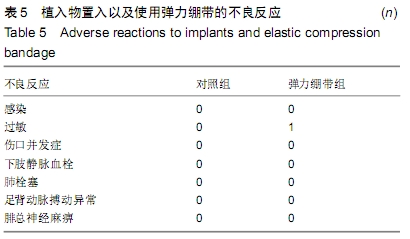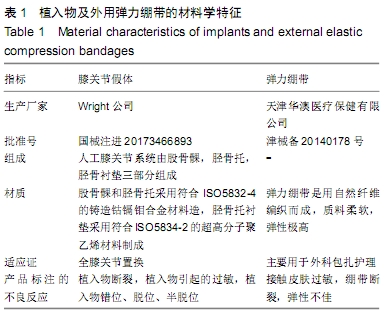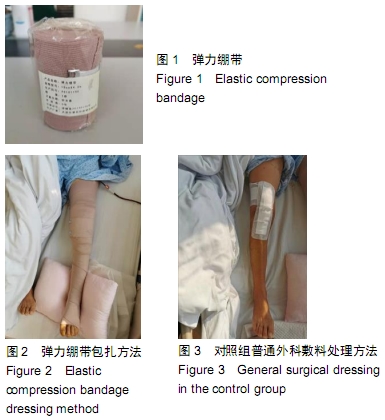中国组织工程研究 ›› 2020, Vol. 24 ›› Issue (24): 3851-3856.doi: 10.3969/j.issn.2095-4344.2737
• 人工假体 artificial prosthesis • 上一篇 下一篇
初次全膝关节置换后弹力绷带的应用
张成龙1,胡 川1,张 铭2,郭祥琳1,孙 康1
- 青岛大学附属医院,1骨科,2肾病科,山东省青岛市 266000
Application of elastic compression bandage after first total knee arthroplasty
Zhang Chenglong1, Hu Chuan1, Zhang Ming2, Guo Xianglin1, Sun Kang1
- 1Department of Orthopedics, 2Department of Nephrology, Affiliated Hospital of Qingdao University, Qingdao 266000, Shandong Province, China
摘要:
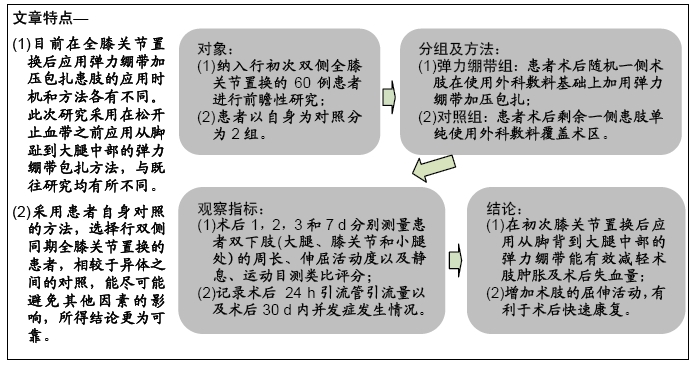
文题释义:
全膝关节置换:是目前治疗晚期原发性骨关节炎或者类风湿性膝关节炎的有效手段。它主要是通过外科手术将膝关节假体置入患者体内,代替原本生理结构,从而达到消除疼痛、恢复力线以及改善功能的目的。
弹力绷带:一般由自然纤维编织而成,治疗柔软,通常用于外科包扎护理。因其具有弹性高、透气性好、不会限制和影响活动、不会妨碍血液循环等独特优势,非常适合应用于关节部位的加压包扎。
背景:全膝关节置换后常规使用弹力绷带到底会不会使患者受益,目前仍缺乏足够的临床证据。
目的:探讨在初次全膝关节置换后使用弹力绑带是否对患者的预后有益。
方法:选择2017年9月至2018年9月因膝关节骨关节炎在青岛大学附属医院西海岸院区关节外科接受初次同期双侧全膝关节置换的60例患者,随机选择一侧肢体使用普通外科敷料的同时使用从脚背到大腿中部的弹力绷带加压包扎(弹力绷带组),一侧肢体只使用普通外科敷料(对照组)。所有患者对治疗方案均知情同意,且得到医院伦理委员会批准。由不参与患者管理的专业人员,在术后1,2,3和7 d分别测量患者双下肢(大腿、膝关节和小腿处)的周径、伸屈活动度以及静息、运动疼痛目测类比评分,记录术后24 h引流管引流量以及术后30 d内并发症发生情况。
结果与结论:①术后第1,2,3,7天,弹力绷带组大腿、膝关节以及小腿周径均小于对照组,膝关节活动度优于对照组,差异有显著性意义(P < 0.001);②术后第1,2天,弹力绷带组静息目测类比评分高于对照组(P < 0.001),但是术后第7天低于对照组(P < 0.001),在术后第3天,2组间差异无显著性意义;弹力绷带组运动目测类比评分在术后第1,2天要大于对照组(P < 0.001),但在术后第3,7天时2组差异无显著性意义;③2组间在伤口愈合并发症方面没有差异,但样本量过小,无法用有意义的统计学方法进行分析;④2组间在术后24 h时引流管引流量差异比较有显著性意义;⑤随访30 d内均未出现深部感染、静脉血栓以及再手术情况;⑥提示在初次膝关节置换术后应用从脚背到大腿中部的弹力绷带能有效减轻术肢肿胀及术后失血量,增加术肢的屈伸活动,有利于术后快速康复,值得推广应用。
ORCID: 0000-0001-6675-8904(张成龙)
中国组织工程研究杂志出版内容重点:人工关节;骨植入物;脊柱;骨折;内固定;数字化骨科;组织工程
中图分类号:
